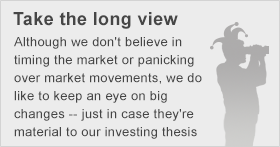
Throughout this week, the Dow Jones Industrials (^DJI 1.18%) have performed in a much different way than they have throughout most of the past five years, with a 125-point drop as of 12:30 p.m. EDT pointing to the very real possibility of a fourth straight day of index declines. Yet even in the face of dramatic uncertainty around the world and a stock market that many see as being at unsustainably lofty levels, the lack of fear here indicates that investors don't see recent events as a reason to become any less confident in the market's future prospects. Even while the much-followed Fear Index, more formally known as the S&P 500 Volatility Index (^VIX +12.86%), was up about 4.8% shortly after midday, it still rests well below where we stood at the beginning of February -- let alone more turbulent times in the past that arguably were more comparable to the current economic and geopolitical situation. What explains the lack of fear in the market?
Crying wolf too many times
In large part, the current complacency in the market simply reflects the number of times that nervous investors have gotten burned by their fears for the future. On countless occasions in the past five years, many have expected extensive corrections after long bullish runs, pointing to situations such as the European sovereign-debt crisis and the collapse in commodity prices as potentially spurring more pessimism about stock markets worldwide. Yet time after time, the markets ignored warning signs and moved higher, leaving behind those who'd moved to the sidelines without having reaped substantial gains.
Moreover, complacency has been a much more lucrative strategy among volatility-tracking investments than betting on fear. The VelocityShares Daily Inverse VIX ST ETN (NASDAQ: XIV) has gained another 13% since the beginning of February, mostly offsetting January's losses and adding to amazing performance in 2013. On the other side of the coin, the iPath S&P VIX ST Futures ETN (VXX +0.00%) is only up 5% so far this year, and it has fallen more than 15% since the market's early February lows, exacerbating huge losses last year. Over the past two years, the inverse-volatility tracker has tripled, while the iPath ETN has lost a whopping 87% of its value.
Risky business
The problem with continued complacency is that even though it might prove right the vast majority of the time, you can suffer huge losses when problems do arise. For instance, again looking at the VelocityShares Inverse ETN, you'll see a solid uptrend over the past two years, but you'll also see plenty of occasions on which the volatility tracker dropped 20% or more in a very short period of time. That underscores the need to have conviction about an anti-volatility call, in order to avoid getting whipsawed out at the time of maximum losses.
At some point, the complacent markets we've seen over the past couple of years will likely give way to more dangerous periods resembling 2011, when fear caused the iPath ETN to soar 150% in just a couple of months. For now, though, complacency still rules the day, and it will likely continue to do so until one of the many threats in the market makes its full force felt.
